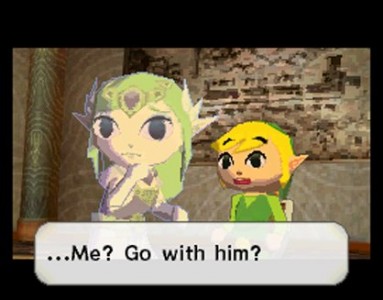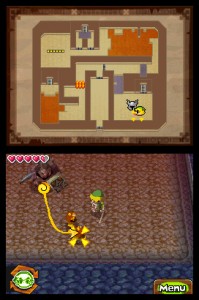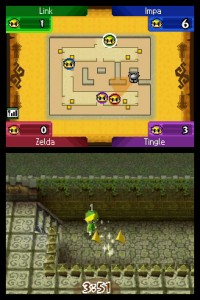
 Taking place many years after Phantom Hourglass, The Legend of Zelda: Spirit Tracks takes Link on yet another adventure through Hyrule. However, instead of traveling by horse or boat, Link is now a train engineer and goes everywhere on his trusty steam engine. When I first heard this news I wasn’t exactly jumping for joy. Fortunately, like most Legend of Zelda titles, Spirit Tracks is filled with puzzle filled dungeons and epic boss fights. Long time Zelda fans as well as newcomers to the series will want to give this game a look.
Taking place many years after Phantom Hourglass, The Legend of Zelda: Spirit Tracks takes Link on yet another adventure through Hyrule. However, instead of traveling by horse or boat, Link is now a train engineer and goes everywhere on his trusty steam engine. When I first heard this news I wasn’t exactly jumping for joy. Fortunately, like most Legend of Zelda titles, Spirit Tracks is filled with puzzle filled dungeons and epic boss fights. Long time Zelda fans as well as newcomers to the series will want to give this game a look.

Cat-eyed Link and Zelda return in Spirit Tracks
If you’ve played any other Zelda game before this one you will know the basic story of Spirit Tracks, and its resolution, about a half an hour into the game. Most of the elements of a classic Zelda story are here including an evil demon terrorizing the land, the collecting of new weapons and objects to help destroy said evil demon and a magical musical instrument to help you throughout your adventure.
That being said, I enjoyed the way the story was told. Instead of bringing back Gannondorf, the evil demon is a brand new character named Malladus that terrorized Hyrule over a hundred years ago, but was sealed away until someone decided they wanted to resurrect him. Also, the idea of the spirit tracks is interesting. Originally the spirit tracks were used to contain Malladus, but then people started traveling on them. When Malladus is being resurrected, the spirit tracks naturally disappear, so Link has to travel to the different temples to bring the tracks back and open up new parts of Hyrule.
If you’re in no hurry to play through the story, Spirit Tracks offers up plenty of stuff to do on the side. These side quests include transporting people, transporting goods or playing mini games. Rewards for doing these missions can range from upgrades to your weapons arsenal to unlocking more of the spirit tracks and traveling to new places. These are not required to complete the story, but if you like getting 100% on all of the games you play, this will add a lot more time onto the game play.

The train can actually be pretty cool
Spirit Tracks continues with the cartoon look as seen in Phantom Hourglass and Wind Waker. The game looks very similar to Phantom Hourglass, which means it looks great by DS standards. The character and monster models are varied and original, the dungeons all have their own unique look and feel to them and the over world is vibrant, colorful and always a joy to look at while you are on your train.
A staple in the Zelda series has always been the epic music that comes with it. This entry is no exception. The soundtrack for Spirit Tracks is fantastic and filled with energy. The most notable song is the one that plays while you are on the train. The main train theme sounds like your typical fantasy song, but with a western feel. The rest of the sound is pretty run of the mill. Sound effects like bombs blowing up and the sword swinging sound like they should, and the characters still prefer to yell at random times instead of talk, which isn’t necessarily a bad thing.
Spirit Tracks has all of the game play elements you find in every Zelda game, plus some new ones. Some of the additions include controlling the train, controlling Zelda, and utilizing the DS’ microphone. Some of these can be entertaining, but they can also be quite frustrating. Along with these new additions to the gameplay, you will find that the entire game is stylus controlled, which is great for some things, but not so great for others.
The first thing I noticed about Spirit Tracks was the control style. I’m not a big fan of having to control everything with the stylus, and in Spirit Tracks some of it feels natural, while other times it feels forced. The train controls are solid and fun to use, but when Link is on foot the stylus has too many jobs. Tap and hold to move, double tap to roll, and attack by tapping an enemy or by quickly moving the stylus across the touch screen. I know they’re trying to use the DS to the fullest, but the puzzles that required more precise movements would have been much less taxing with traditional controls.
When this title was first announced, I was wondering how controlling a train on already set up tracks could be fun. There seems to be no opportunity to explore the world other than where the tracks lead you. Having the tracks cover most of the world and giving the players speed settings and choices on where to go when the tracks split solve this problem. When you get to a certain point in the game you can also customize your train with different types of cars. Overall the train controls are implemented well, but there are parts where long train journeys can drag on for what seems like forever.

The woes of controlling Zelda
The aspect about the train that disappointed me was that it was used as a tool to artificially lengthen the game. Opening up paths to new temples always took a little work, but some of it was unnecessary. One specific example I remember is traveling from the top-left corner of the map to the bottom-right corner only to find that the bridge was out. Not long after I learned that the bridge repair main lived in the top-left corner of the map, so I had to travel all the way back, pick him up and bring him to the broken bridge. I know it would be too easy to just go from temple to temple without any obstacles, but things like the bridge scenario seem a little excessive.
The next addition to this game is your ability to control Zelda. Unfortunately, this aspect of the game is more frustrating than fun. The premise behind controlling Zelda is the fact that she follows you around as a spirit. She is sort of like Navi from Ocarina of Time, only considerably less annoying. There is a temple you have to keep revisiting and after doing some preliminary work, Zelda is able to control one of the armored phantoms in the temple.
Actually controlling Zelda is more of a chore than an innovative control style. The way you control her is by touching a button at the armored phantom’s feet and drawing a line from point A to point B for Zelda to walk along. You will find out very quickly that Zelda’s path finding is terrible and she will walk into walls, or get stuck on something unless you babysit her every step of the way. What makes this worse is you have to do this throughout the course of the entire game since you have to keep revisiting this one temple. You may not have to redo the same floors like in Phantom Hourglass, but this control method wore heavily on my patience and it should have been implemented better.
The last of the notable new features is the use of the microphone. The musical instrument in Spirit Tracks is a set of panpipes and there is also a weapon that makes mini tornadoes that Link uses throughout his adventure. Both of these require you to blow into the microphone and that’s fine… if you’re not in public. The purpose of a handheld system is to play it on the go, so it is going to look really weird when you start blowing into your DS like a maniac trying to solve a timed puzzle or play a song. It’s not a deal breaker, but you will probably want to keep Spirit Tracks confined to the privacy of your home.

Spirit Tracks' multiplayer mode
Spirit Tracks still has the elemental temples and the great boss fights that most Zelda games are known for. Each temple besides the main one is a blast to play through and the boss fights at the end never disappoint. Some of the puzzles can be pretty easy, but others will have you scratching your head for a little while. Even though there are some new additions to this game that might not be for the best, the core of the game is still classic Zelda.
In addition to the single player mode, there is also a multiplayer battle mode. Up to four people can play off of one cartridge and each person is Link with a different colored tunic. The point is to collect as many force gems (gems that look like triforce pieces) as possible. You can collect power ups to make other players drop their gems and there is a phantom walking around that will try to hit the players. Overall it feels tacked on and it is definitely not the main focus.
Spirit Tracks is worth a look mainly because it continues the Zelda storyline. The story is well told, even if fans have heard it all before and the graphics and sound are great. The core game play of going through the temples is very fun, but some of the new additions could have been implemented better and the stylus controls are finicky at times. Spirit Tracks is worth renting and playing through, but the overly frustrating aspects of the game might not leave you wanting more.
– — – — – — – — – –
Published by: Nintendo
Developed by: Nintendo EAD
ESRB Rating: E for Everyone
Platforms: DS
Release Date: December 7, 2009
Genre: Action-Adventure

Nintendo: Preserving the status quo. Although I’m kinda sick of the stylus Zeldas. Why don’t they try a sprite-based Zelda using the DS’ regular controls? Or a port of LttP?
Another port, Eliot. The GBA one from 2002 wasn’t that long ago. And it was a timely release, on the heels of the protests of the chibified looking Link in Wind Waker.
Gamepro’s review said it best: “This isn’t a Kojimasque tale of morality gone amuck, and at one point the hero gets turned into a fluffy pink bunny. Wherever the idea of Link looking kiddy started, it sure wasn’t here.”